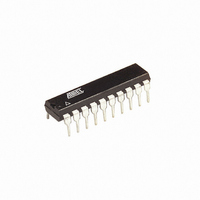ATTINY26L-8PU Atmel, ATTINY26L-8PU Datasheet - Page 97

ATTINY26L-8PU
Manufacturer Part Number
ATTINY26L-8PU
Description
IC MCU AVR 2K 5V 8MHZ 20-DIP
Manufacturer
Atmel
Series
AVR® ATtinyr
Datasheets
1.ATTINY26-16MC.pdf
(18 pages)
2.ATTINY26-16MC.pdf
(182 pages)
3.ATTINY26L-8PU.pdf
(183 pages)
Specifications of ATTINY26L-8PU
Core Processor
AVR
Core Size
8-Bit
Speed
8MHz
Connectivity
USI
Peripherals
Brown-out Detect/Reset, POR, PWM, WDT
Number Of I /o
16
Program Memory Size
2KB (1K x 16)
Program Memory Type
FLASH
Eeprom Size
128 x 8
Ram Size
128 x 8
Voltage - Supply (vcc/vdd)
2.7 V ~ 5.5 V
Data Converters
A/D 11x10b
Oscillator Type
Internal
Operating Temperature
-40°C ~ 85°C
Package / Case
20-DIP (0.300", 7.62mm)
Processor Series
ATTINY2x
Core
AVR8
Data Bus Width
8 bit
Data Ram Size
128 B
Interface Type
2-Wire/ISP/SM-Bus/SPI/UART/USI
Maximum Clock Frequency
8 MHz
Number Of Programmable I/os
16
Number Of Timers
2
Operating Supply Voltage
2.7 V to 5.5 V
Maximum Operating Temperature
+ 85 C
Mounting Style
Through Hole
3rd Party Development Tools
EWAVR, EWAVR-BL
Development Tools By Supplier
ATAVRDRAGON, ATSTK500, ATSTK600, ATAVRISP2, ATAVRONEKIT
Minimum Operating Temperature
- 40 C
On-chip Adc
11-ch x 10-bit
Controller Family/series
AVR Tiny
No. Of I/o's
16
Eeprom Memory Size
128Byte
Ram Memory Size
128Byte
Cpu Speed
8MHz
Rohs Compliant
Yes
For Use With
ATSTK600 - DEV KIT FOR AVR/AVR32770-1007 - ISP 4PORT ATMEL AVR MCU SPI/JTAGATAVRISP2 - PROGRAMMER AVR IN SYSTEMATSTK505 - ADAPTER KIT FOR 14PIN AVR MCU
Lead Free Status / RoHS Status
Lead free / RoHS Compliant
Other names
ATTINY26L-8PJ
ATTINY26L-8PJ
ATTINY26L-8PJ
Available stocks
Company
Part Number
Manufacturer
Quantity
Price
Company:
Part Number:
ATTINY26L-8PU
Manufacturer:
Atmel
Quantity:
25 295
Part Number:
ATTINY26L-8PU
Manufacturer:
ATMEL/爱特梅尔
Quantity:
20 000
1477F–AVR–12/04
The successive approximation circuitry requires an input clock frequency between
50 kHz and 200 kHz. The ADC module contains a prescaler, which divides the system
clock to an acceptable ADC clock frequency.
The ADPS bits in ADCSR are used to generate a proper ADC clock input frequency
from any chip clock frequency above 100 kHz. The prescaler starts counting from the
moment the ADC is switched on by setting the ADEN bit in ADCSR. The prescaler
keeps running for as long as the ADEN bit is set, and is continuously reset when ADEN
is low.
When initiating a conversion by setting the ADSC bit in ADCSR, the conversion starts at
the following rising edge of the ADC clock cycle. If differential channels are selected, the
conversion will only start at every other rising edge of the ADC clock cycle after ADEN
was set.
A normal conversion takes 13 ADC clock cycles. In certain situations, the ADC needs
more clock cycles to initialization and minimize offset errors. Extended conversions take
25 ADC clock cycles and occur as the first conversion after the ADC is switched on
(ADEN in ADCSR is set).
Special care should be taken when changing differential channels. Once a differential
channel has been selected, the gain stage may take as much as 125 µs to stabilize to
the new value. Thus conversions should not be started within the first 125 µs after
selecting a new differential channel. Alternatively, conversions results obtained within
this period should be discarded. The same settling time should be observed for the first
differential conversion after changing ADC reference (by changing the REFS1:0 bits in
ADMUX).
The actual sample-and-hold takes place 1.5 ADC clock cycles after the start of a normal
conversion and 13.5 ADC clock cycles after the start of an extended conversion. When
a conversion is complete, the result is written to the ADC Data Registers, and ADIF is
set. In Single Conversion mode, ADSC is cleared simultaneously. The software may
then set ADSC again, and a new conversion will be initiated on the first rising ADC clock
edge. In Free Running mode, a new conversion will be started immediately after the
conversion completes, while ADSC remains high. Using Free Running mode and an
ADC clock frequency of 200 kHz gives the lowest conversion time, 65
15 kSPS. For a summary of conversion times, see Table 43.
Figure 53. ADC Timing Diagram, Extended Conversion (Single Conversion Mode)
Cycle Number
ADC Clock
ADEN
ADSC
ADIF
ADCH
ADCL
1
2
MUX and REFS
Update
12
13
14
15
Sample & Hold
16
Extended Conversion
17
18
19
20
21
22
Conversion
Complete
23
24
ATtiny26(L)
25
MSB of Result
LSB of Result
µs
, equivalent to
Next
Conversion
1
2
MUX and REFS
Update
3
97


















